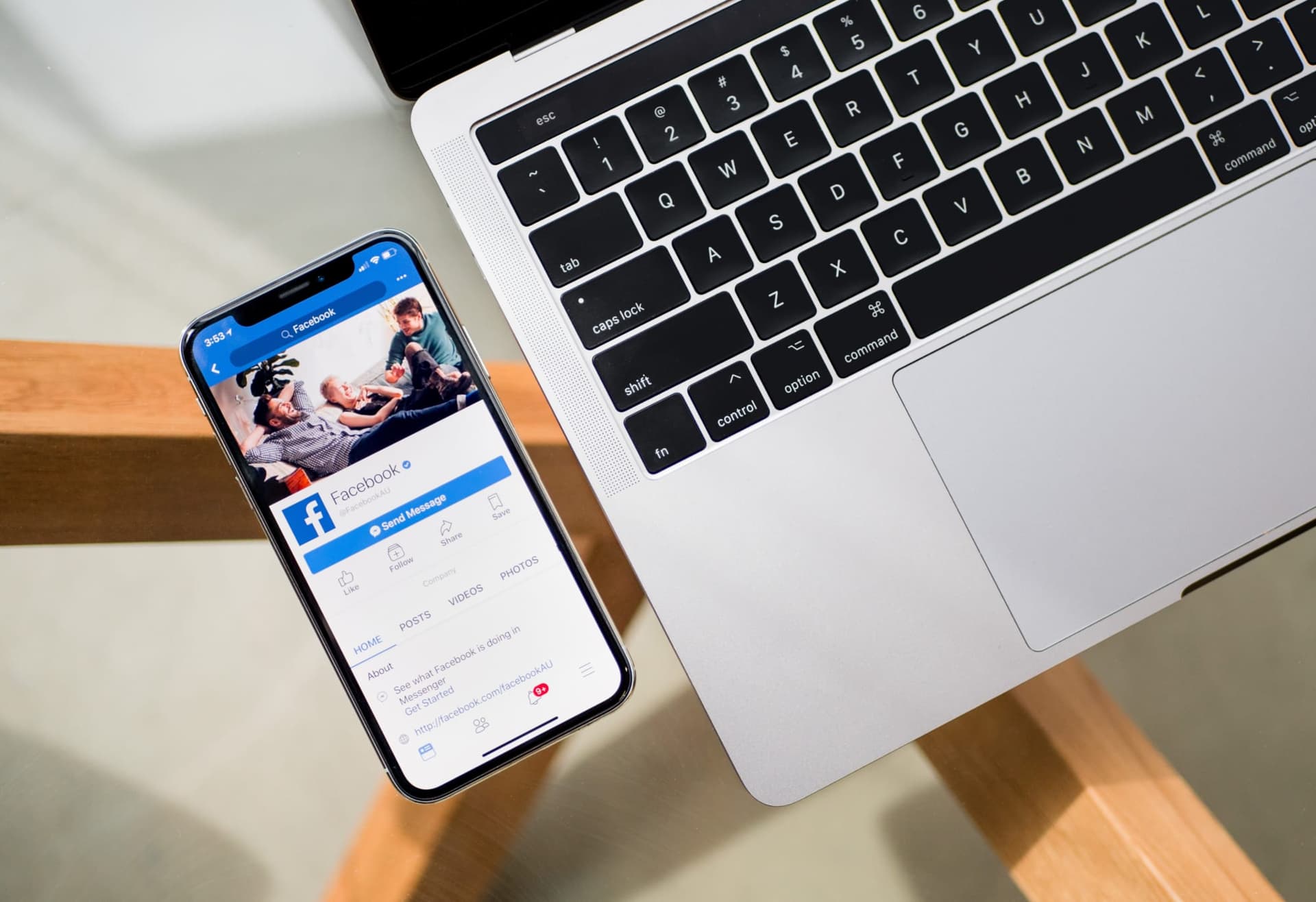Whenever I get asked what my favorite book is, I always reply The Pirates Dilemma.
The book tells the story of punk, disco, hip-hop, graffiti, and how modern technology has made the ideas and innovations of youth culture increasingly intimate and increasingly global at the same time.
It’s truly fascinating.
And when you look back, you can see the origins of the current social media revolution can be traced as far back as the 70’s (if not even further).
Back in the 70’s punk was the start of a revolution. Now, the only things that have changed are the platforms and the ease at which we can connect and create.
Here’s the history of social media: how it all started, why Facebook rose to #1 (and why it might not stay that way) and some bold predictions on where it’s all heading.
Let’s dig in.
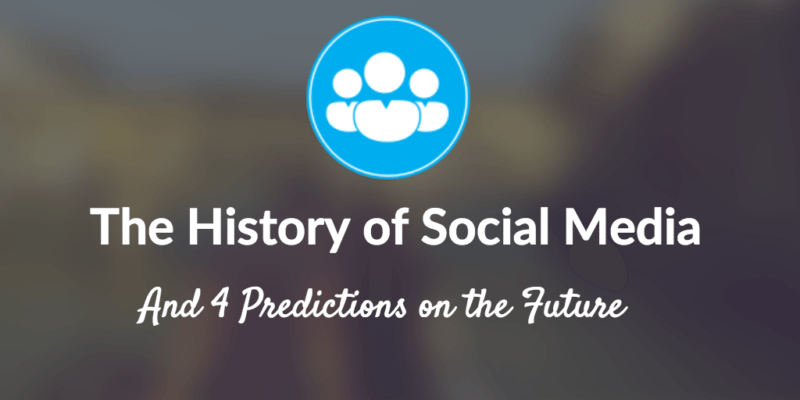
First things first, why I had to write this
I really want you to get value from this article, I have to be honest, though, its creation wasn’t entirely selfless. At Buffer we’re always looking for “what’s next.”
Over the past 12 months we’ve lost half of our social referral traffic. And we’ve started looking deep within ourselves to figure out how to stay at the top of our game.
Every single day I take notes and write about social media marketing, but I don’t put enough time aside to reflect on how it’s all changing, where it’s heading and what that means for me personally as a marketer and for our whole team at Buffer.
This post is an exploration of social media. A reflection on how it all came to be and a way to formulate some ideas on where it’s all going.
I hope you find some value in this post and I’d love to hear your thoughts in the comments. ?
A brief history of social media (the stuff you probably didn’t already know)
You might have seen David Fincher’s 2010 film ‘The Social Network’ which tells the story of Facebook, or read about how The Facebook was born out of a dorm room at Harvard University.
And it’d be easy to believe that is where social media started.
However, while Facebook has risen to the top and become the World’s #1 social network, the sparks of the social media revolution started flying long before Mark Zuckerburg even started college.
The start of a revolution
The Pirates Dilemma starts with focus on a quote from punk fanzine with a diagram showing three finger positions on the neck of a guitar with the caption:
“Here’s one chord, this is another, here’s a third, now form your own band.”
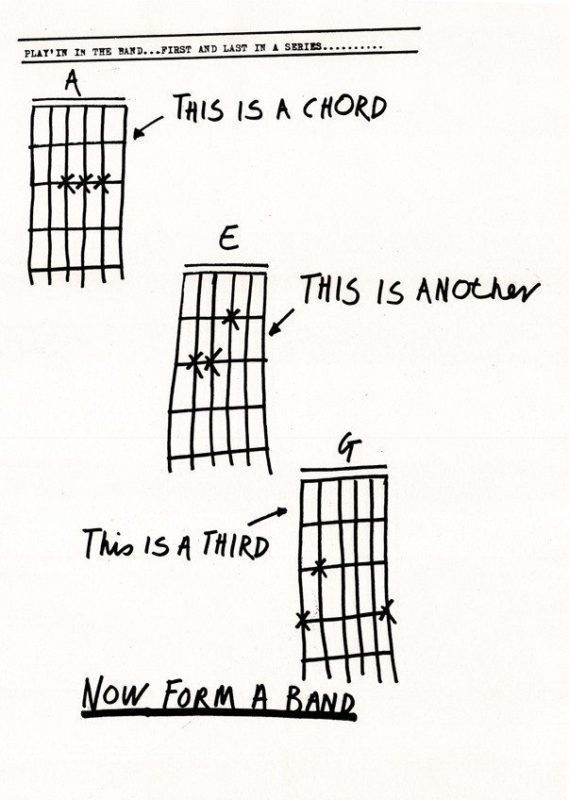
The punk movement made the barriers to music creation lower and inspired a generation of rebels and creators to do it for themselves.
And culturally, it started to blur the lines between broadcaster and consumer (something that is now at the forefront of society — everyone can create and broadcast content).
What started out in punk, moved to Disco where DJ’s in NYC would mix together tapes to create their own music, then to Hip-Hop and so on. Social media is a natural evolution of these subcultures, born out of people’s innate desire to connect and create.
Dave Allen—the original bassist for post-punk band Gang of Four and digital strategist explains further at Fast Company:
The punk rock ethos allows anyone to pick up an instrument and pound on it and put themselves out there. We had something to say and we found a way to say it. Today you can have something to say online and that is punk rock, your instrument can be your computer.
Just like disco and hip-hop, social media has now reached and influenced mainstream pop culture. And though social media has grown incredibly fast, it didn’t happen overnight.
The first ‘social network’
Social media has been evolving since the invention of the Internet. From the first email in 1971 and Usenet in 1979 to GeoCities allowing everyone to set up their own personal homepage in 1995.
However, Six Degrees is widely considered to be the first social network.
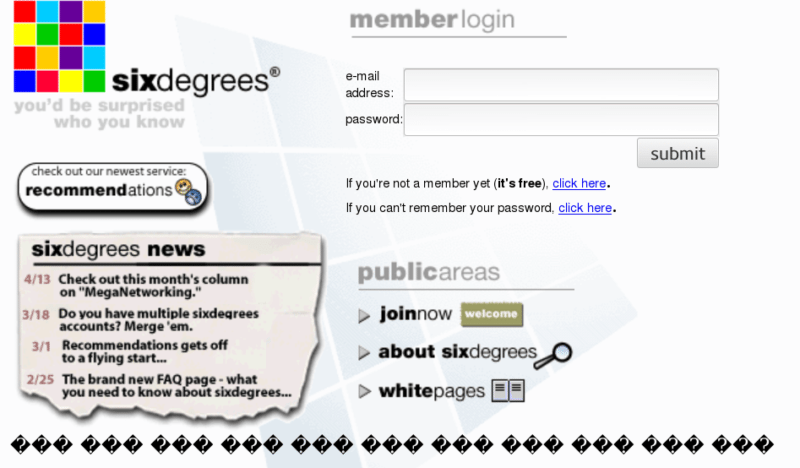
According to Wikipedia:
It was named after the six degrees of separation concept and allowed users to list friends, family members and acquaintances both on the site and externally; external contacts were invited to join the site. Users could send messages and post bulletin board items to people in their first, second, and third degrees, and see their connection to any other user on the site.
Six Degrees launched in 1997 and grew to around 3,500,000 registered users and was sold to YouthStream Media Networks in 1999 for $125 million.
So why aren’t we using Six Degrees today?
At lot of it has to do with timing. In 1997, the Internet’s infrastructure wasn’t really ready for social networking and while the site had millions of registered users, growth was limited due to the lack of people connected to the Internet.
The evolution of social media
Six Degrees was followed by social networking sites based on the “social-circles network model.” A slightly different approach than the “Six degrees of separation” model .
Instead of connecting with people you see as first, second or third degree connections. Social circle networks allow you to connect with anyone you know, whether they’re best friends or acquaintances.
To highlight how social media has evolved, let’s take a look at a few of the seminal platforms that helped the social media phenomenon take off.
Friendster
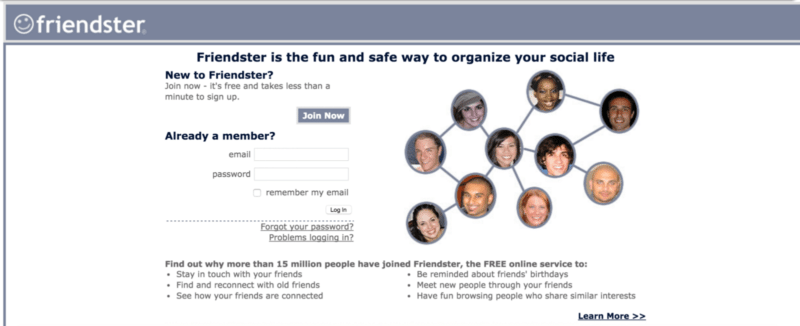
Friendster was founded in 2002 and at its peak had more than 100 million users. Sadly, after many struggles to re-invent itself, Friendster’s doors closed on June 14, 2015.
The site was many people’s intro to online social networking, but like many before and after, the network failed to become a part of users’ daily routine and ultimately people skipped off when newer, shinier social networks emerged.
Myspace
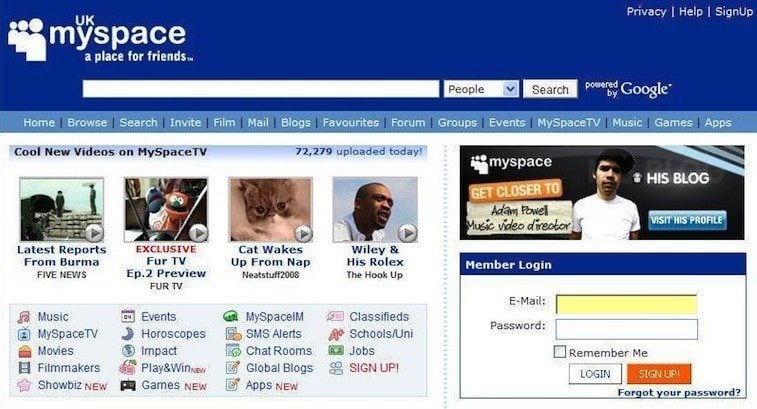
From 2005 until 2008, Myspace was the largest social networking site in the world, and in June 2006 surpassed Google as the most visited website in the United States.
Facebook overtook Myspace in May 2008 and since then the platform has been playing catch-up and trying to re-invent itself.
What kills a social network
There are hundreds, if not thousands of reasons that social networks decline. The Swiss Federal Institute of Technology studied networks like Friendster and Myspace with the goal of figuring out what kills a social network.
They found that when the time and effort (the costs) associated with being a member of a social network outweigh the benefits, then a decline in users becomes likely. If one person leaves, their friends become more likely to leave and as more people leave, this can lead to a cascading collapse in membership.
While networks like Friendster and Myspace had tens, and eventually hundreds, of millions of registered users the bonds between users weren’t particularly strong. Many users had very few connections and as such felt looser affiliation with the networks.
On the decline of a network, David Garcia, a professor with the Swiss Federal Institute of Technology explains:
“First the users in the outer cores start to leave, lowering the benefits of inner cores, cascading through the network towards the core users, and thus unraveling.”
You can see how a social network unravels in the below graphic (Friendster is used in the image):
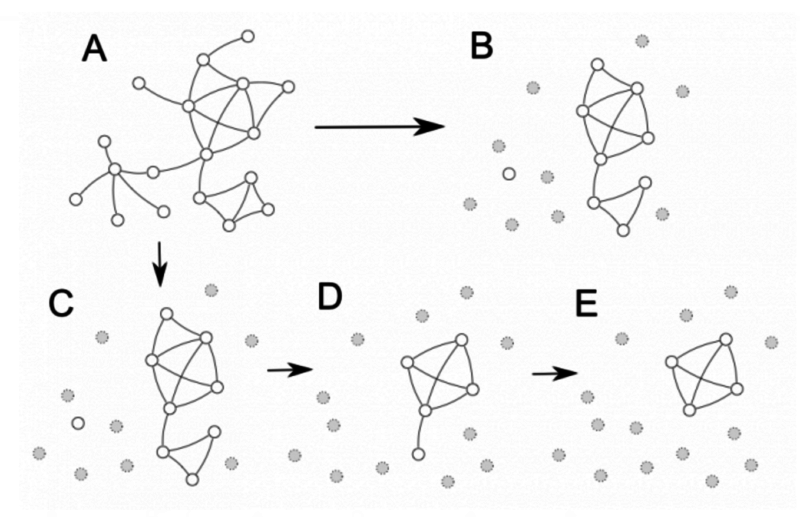
This shows that it takes more than just a large user base to build a social network. Strong social networks are made up on strongly linked people, not large groups of strangers and acquaintances.
Why Facebook became the #1 social network in the World
“The world had been trained by MySpace that social networking was interesting, but the actual product had been perfected by Facebook.” — Mike Jones, former MySpace CEO
Facebook has risen to the top of the social media world with ~ 1.49 billion monthly active users.
You could write a book on how Facebook has grown to become the most dominant social network of our time, but I’m going to try and summarise its meteoric rise in just a few bullets points.
Being real
Facebook was the first social network that encouraged you to use your real name instead of a nickname or pseudonym as Mike Jones explains:
MySpace put up barriers to user enjoyment by forcing members to use anonymous pseudonyms in place of their real identities. Facebook, on the other hand, encouraged members to actually use their real names; once this behavior was ingrained in the public, and people saw that it wasn’t the huge risk it was made out to be, Facebook took off and never looked back. This significant difference between the two social networking sites proved to be a huge game changer in the two companies’ experiences.
Willingness to change
During Facebook’s rise they adopted the mantra “move fast and break things.” Putting this belief into action is a huge reason why Facebook rose above their competition.
Facebook has never stood still and they’ve never been afraid to make bold changes to their platform.
Here’s a chart showing some of their major updates between 2004-2012:
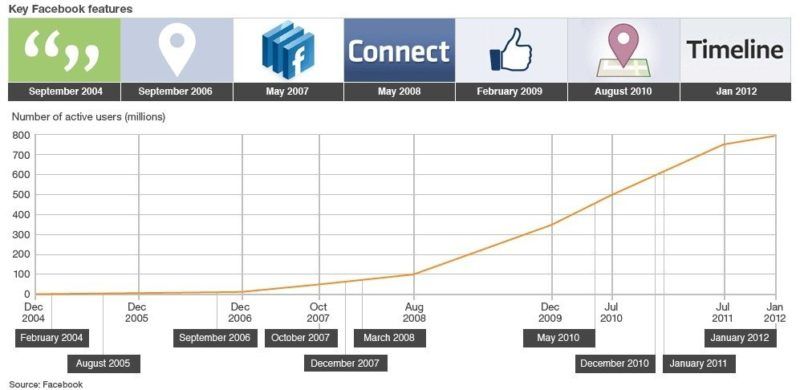
Some key milestones:
- September 2004: The Wall, allows users and their friends to post and share content to each others’ profiles.
- September 2006: Newsfeed is introduced – now users can see what their friends are doing on Facebook.
- January 2012: The timeline style profile is launched for all users.
Introducing the Newsfeed
The Facebook Newsfeed has been a key part of their success. On early social networks (and Facebook before the Newsfeed introduction), you had to go off in search of content from connections.
The Newsfeed put your friends’ content, updates and discussions front and center, giving Facebook a truly social feel.
Understanding the importance of strong connections
A little earlier we discussed the importance of connections on social networks and this is something that Facebook has focused on heavily as Alex Schultz explained in his Ycombinator lecture on growth:
Zuckerberg talked at Y Combinator about getting people to 10 friends in 14 days; that is why we focus on this metric. The number one most important thing in a social media site is connecting to your friends, because without that, you have a completely empty newsfeed, and clearly you’re not going to come back; you’ll never get any notifications, and you’ll never get any friends telling you about things they are missing on the site.
Where is all this heading?
“It’s never the end game. Facebook is now a platform upon which all kinds of applications are being built it’s definitely not it. It would be incredibly presumptuous and self-serving of me to believe that Facebook was the end of history. The only way it could possibly be the end of history is if it becomes some sort of artificial super intelligence that takes over the world.”
— Sean Parker
During Myspace’s heydey, no-one outside of a certain Harvard dorm room would have predicted Facebook, just as Facebook didn’t see Snapchat coming and again changing the way millions of people connect with each other.
Facebook has reached the highest of highs, and much like a fighting World Champion boxer, they face a tough battle to keep their place on a pedestal and remain at the top.
Although the future of social media is uncertain, here’s my best go at predicting what’s coming next.
Four predictions on the future of social media
Greater focus on personality
One of the reasons Facebook beat out Myspace was that it was the first network that allowed us to be ourselves (by using our real names) and as it evolves, social media will continue to become more personal.
As Beme co-founder and filmmaker Casey Neistat explains:
“Social media, it’s supposed to be a digital or virtual version or who we are as people. Instead it’s this highly sculpted, calculated, calibrated version of who we are.”
Social networks will start to become more genuine. Focusing on who we actually are as individuals, as opposed to the edited version of ourselves we currently put forward.
Platforms will move beyond static images and text-based profiles and evolve to feel more alive) we’re already starting to see this come to fruition with Facebook’s introduction of profile videos).
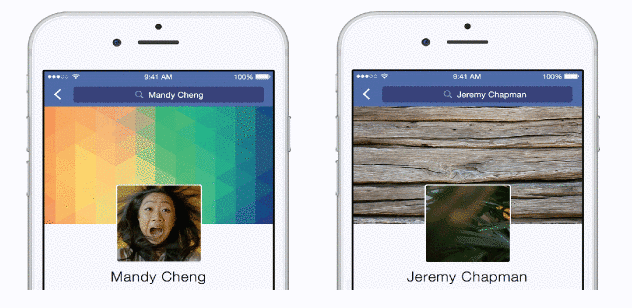
Hand-delivered content
A Tweet currently has a shelf life of 18 minutes. The average Facebook user has access to about 1,500 posts per day but only looks at 300.
Content is overwhelming. And it’s a problem for both users of social media platforms and marketers.
At the moment content is produced en-masse and we share it with our followers at a time we deem to be most relevant. This isn’t ideal. As social media becomes more personal, so will the way we deliver content.
In years to come, content will feel hand-delivered. We’ll be able to tailor content to specific individuals in real time based on their routines and interests. Facebook is already testing an AI to determine what content is in photos in order to serve the most relevant ones in your timeline.
This creates a strong value proposition for the social network users (relevant content to them every time they login) and will help users to feel connected to other people, brands and their favourite pages, thus boosting the longevity of social networks.
A hand delivered approach to content will also boost content engagement as users will have an immediate reason to read and engage with content that is in their feed as opposed to mass produced content for everyone.
The still image becomes a thing of the past
Video and multimedia content is booming in social media. The most effective post types for Facebook are now videos and Twitter’s own data on video is fascinating:
The majority of Twitter users (82%) watch video content on Twitter and most watch on a hand-held screen. A staggering 90% of Twitter video views happen on a mobile device, according to our own internal data. But Twitter users don’t just lean back and watch video; they also lean in to create it. Twitter users are 1.9x more likely to have uploaded a video online (anywhere) than the average U.S. internet user.
Alongside video, GIFs have also bounced back to the forefront of social media.
“When MySpace faded away and Facebook took over with an anti-animated GIF policy it cleansed the internet of the sparkly 90’s style GIFs that were so prevalent,” explains Kevin Burg, Co-creator of Cinemagraph.
“In the wake of that was Tumblr, which had an artistic and creative community plus loads of bandwidth, a 512kb file limit on GIFs and a super simple way to share them. The spirit of Tumblr then was about creating rich content and lots of people were experimenting with how to use that 512kb most effectively or creatively.”
The rise of Tumblr, along with sites like Giphy, paved the way for gifs to become mainstream again. Both Facebook and Twitter have now opened up to GIFs (something we’ve also started supporting at Buffer).
We’ve been through the revolution where every company is a media company, now, and in the future, every company will need to be a multimedia company.
Attention spans become even shorter
Attention is becoming an increasingly scarce resource. A Microsoft study that found the average attention span of an internet user has dropped substantially from 12 seconds in 2000, to just eight seconds in 2015.
To counter our declining attention spans, content will become event more interactive and allow us to create our own unique experiences. One way this is already coming to life is through 360 degree video on platforms like YouTube.
Here’s an example (hover over the video and you can pan around 360 degrees while it plays):
Over to you: your thoughts on the past, present and future of social media
What was the first social network you actively used? And how has social media changed since then?
What do you feel the future of social media looks like? Where are we heading?
It’d be amazing to hear your thoughts on this truly exciting subject. Feel free to leave any thoughts at all in the comments below, and I’d love to jump in and join the conversation!
Try Buffer for free
190,000+ creators, small businesses, and marketers use Buffer to grow their audiences every month.


